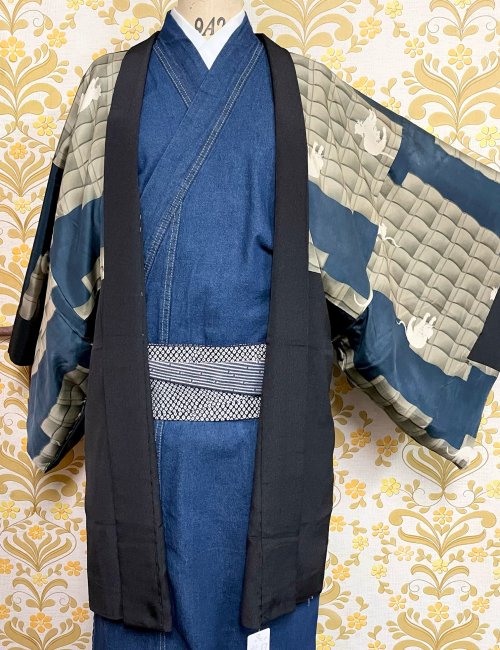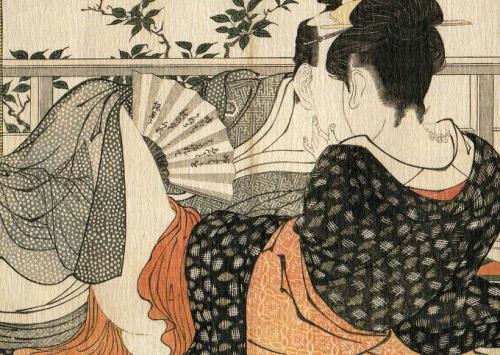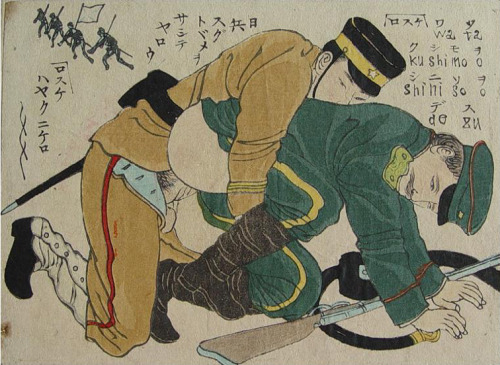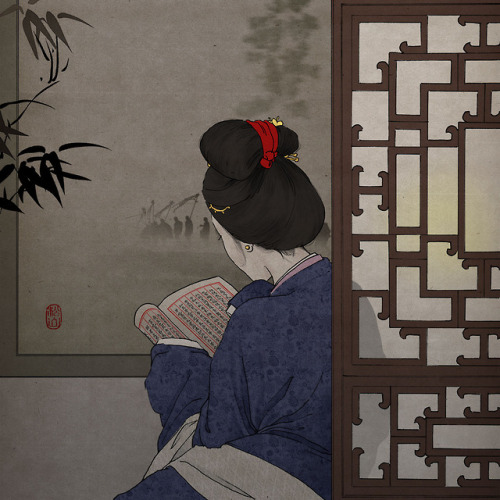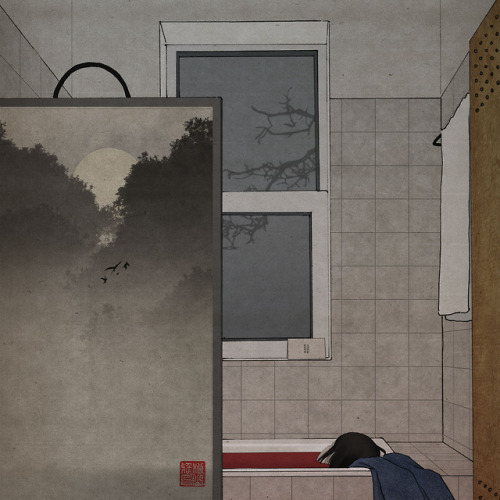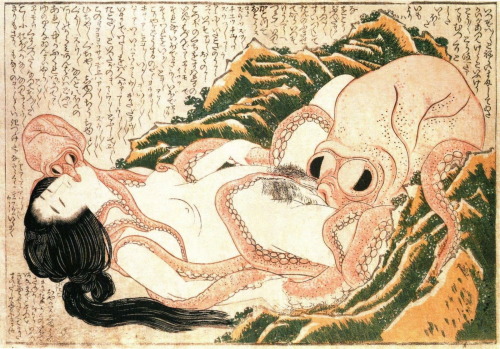#shunga

No, I don’t like Fun Factory.
Super unusual pattern for this haori lining (haori is here worn inside out) depicting cats on a tile roof (and a shunga in the back? that lady looks quite dishevelled ^^;)
Post link
Dildo
1820’s original Shunga woodblock print by Keisai Eisen. $200
For more information and scans contact me at [email protected]
#érotisme #eroticart #eroticillustration #art #illustration #interiordesign #interiordecorating #decorating #design #antiqueprint #antique #vintage #printmaking #prints #shunga #japaneseart #ukiyoe
https://www.instagram.com/p/BPavkjgFt0I/?utm_source=ig_tumblr_share&igshid=v252xejecbpa
Post link
SOLD
Detail of an original Japanese Shunga (Picture of Spring) woodblock print by Hiroshige from the Genjimon series, circa 1840.
$200.00
For more information and scans contact me at [email protected]
#érotisme #eroticart #eroticillustration #shunga #ukiyoe #japaneseart #art #illustration #interiordesign #interiordecorating #decorating #design #antiqueprint #antique #vintage #printmaking #prints
https://www.instagram.com/p/BREQ8H_FK2L/?utm_source=ig_tumblr_share&igshid=3jead8xxcst
Post link
Japanese propaganda poster from the time of the Russo-Japanese War (1904–1905) depicting a Japanese soldier raping a Russian soldier and withdrawing Russian soldiers. From right to left: Russian soldier: “I feel like I’m gonna die.” / Japanese soldier: “I’ll finish you off right quick.” / Russians: “Hurry, run away!”
Post link
IMAGE SOURCE: Royal Ontario Museum
Today’s piece of gender non-conforming and erotic art history comes to us from the 1850′s of Edo period Japan. (1, p. 198) In this scene, a woman wearing a feminized version of a distinctively men’s hairstyle asserts herself aggressively during sex with a male partner. (1, p. 198) Or, in an alternate source’s view, the image is portrayed as a humor piece about an overly passionate woman and her surprised male lover. (2, p. 156) Given that this is the first time this project has encountered two sources providing conflicting portrayals of an image, this article will examine and weigh both interpretations while also using the opportunity to provide information on the topic of assigned female people who dressed as men in Edo period Japan (1603-1868).
During the Edo period, assigned male children went through three phases of life, each of which had an identifying hairstyle. As can be seen in detail in the image directly below this paragraph, when male children reached the age of twelve or so, they became known as “wakashu”. Their forelocks were shaven (essentially shaving the bang area to slightly recede the hairline), and the remaining forelocks (known as maegami) were then accentuated by shaving the crown of the head behind them. The forelocks were then styled upward and back before tying them off as they arced over the bald crown towards the back of the head. The hair growing on the back of the head behind the bald crown was grown long into a pony tail which would then be folded forwards, and the sidelocks would be styled into symmetrically flaring wings on either side of the head. (1, p. 19) Once the wakashu had his coming of age ceremony into adulthood in his late teens or early twenties, his hair would be cut into a cronmage hairstyle by shaving off his maegami bangs into a fully shaved crown and eliminating his sidelock flares to visually identify him as a yaro, or adult male. (1, p. 26)

IMAGE SOURCE: Royal Ontario Museum
(Above is a New Year’s print for the year 1803 depicting a couple hunting with hawks, (1, p. 104) provided as a reference for common wakashu and female hairstyles of the time.)
Women’s coming of age visual markers involved blackening their teeth once they married (which was considered to be a sign of beauty throughout much of Asia) which was accomplished by painting on a black pigment on a semi-daily basis. Their second coming of age visual indicator was shaving their eyebrows once they have given birth to their first child. (1, p. 19) As can be seen in the illustration directly above, the most distinctive and universal feature in women’s hair was the large comb that ran side to side across the back of the crown of the head. Women also wore flared sidelocks, and with time, they became so large that the effectively created a semi-circle framing either side of the face. The hair on the back of their heads was elaborately woven and stacked, and ornamental wooden hairpins were common, though not universal, and an abundance of hair pins indicated that the person was a sex worker.
Because Edo hairstyles were very stylized and highly gendered, a person could change how their gender was perceived by how they shaved and styled their hair. There is a long history of transmasculine presentation in Japan with stories of warrior women dressed as men going back at least nearly nine hundred years. (1, p. 195) In the Edo period, Kabuki performance was created in 1601 by women and was originally performed by all female troupes with women dressing as men to play male roles. (3) After women were banned from the kabuki stage in 1629, many continued to dress as men in other areas of entertainment. (1, p.26)
Further, while being a geisha was originally an all male occupation employing beautiful and androgynous teenage wakashu, by the 1750′s female geisha began to appear. To blend in with their assigned male peers, the original female geisha frequently shaved their heads and styled their hair in the distinctive manner of wakashu, and became known as “haori geisha” due to the men’s haori jackets they wore. As geisha became a predominantly female occupation by the 1790′s, many abandoned the male look for traditional feminine dress, while others chose to retain the male presentation. (4) Additionally (as geisha did not typically engage directly in sex work), just as onnagata were assigned male actors who specialized in female roles and were available for sex work after their performances, the inverse practice of assigned female people presenting as male making themselves available for sex work after their performances was well known in Edo Japan, as well. (1, p. 35) (4)
In the scene above, a male and assigned female couple has sex on a balcony of a high end brothel (indicated by a woman with a sex worker’s hair style in the background appearing to receive a client in another room of the building visible in the left portion of the background) and with a scenic garden abutting the sea or a lake comprising the rest of the backdrop. In the foreground, a woman is assertively climbing on top of her partner and clings to him with her arms around his neck as he penetrates her. The male partner’s legs are sprawled and he appears to be having an intense experience as he lifts one of his partner’s legs up to facilitate penetration involving both partners greatly exaggerated genitals.
The book “A Third Gender: Beautiful Youths in Japanese Edo-Period Prints and Paintings” published by the Royal Ontario Museum says the following regarding the lady in the print: “Her hairstyle features the forelocks previously distinctive of wakashu secured with a comb…The aggressiveness she displays was considered typical of women who wore the maegami hairstyle”. (1, p. 198) The book, on the whole, was scholarly and well researched (if written by people totally unfamiliar with the difference between gender and sexuality), but the chapter this image is in, “Cross-Dressing Women”, is the briefest and most poorly researched in the book with a number of factual errors easily found by anyone inspired by the chapter to do additional research (including googling a citation provided for further reading which flatly debunks one of the book’s claims regarding a print). (1, p. 194)
Semi-conflictingly, the book “Shunga: Japanese Erotic Art” translates the writing on the page as saying, “’Let me kiss you!’ pleads the woman, whose heart is entranced by the cherry blossoms.” (2, p. 156) This book, by contrast, is more of an entertainment oriented book intended more for people to pick up and briefly read several erotic pages at random, and most of the translations in the book are highly questionable (ranging from one sentence “translations” of entire paragraphs to one “translation” that contains absolutely no common words or concepts with a complete translation provided by a scholarly source). (2, p. 80)
The translation is not necessarily at odds with the first description, however, the first source implies that it is more of a seriously intended erotic piece depicting a sexually aggressive woman sporting what would essentially be considered a tomboy haircut (in that the maegani bangs and shaved crown are strongly associated with males, but the pin, comb, cherry blossoms, and the rest of the hair arrangement is feminine) whereas the second source makes no mention of her tomboyishness and instead portrays the art as a humor piece about a woman who is enacting a feminine stereotype of being overly emotional and attached, and for that matter, due to the presence of flowers.
If the first source’s interpretation that this is a brothel is accurate (which seems likely given the sex worker in the background with a client), without additional information indicating that this man is somehow special to her or that this display is a part of her normal routine with her clients, the likelihood of a sex worker becoming that overwhelmed by passion with a client is relatively low. That said, given that both sources are very questionable when it comes to this print, there is no way to make a determination as to what circumstances are intended in the scene that is playing out without additional information. This has, however, been an excellent opportunity to examine assigned female cross dressing in Edo period Japan. To close out the article, one additional supplemental image is provided, below.
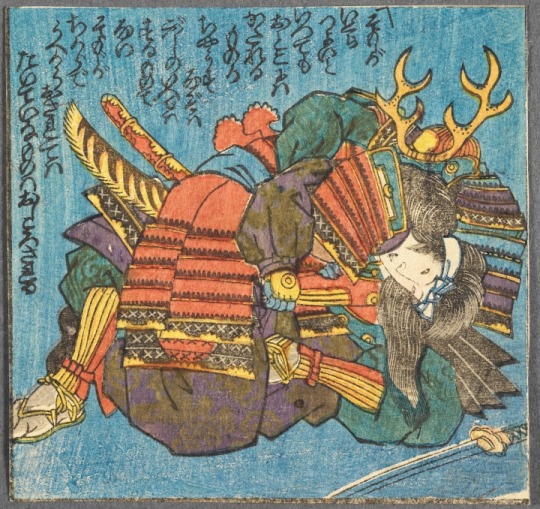
IMAGE SOURCE: Royal Ontario Museum
Above is a circa 1830 print of a woman warrior, possibly Tomoe Gozen from the 12th century military epic “The Tale of Heike”, fighting a mostly obscured man wearing a helmet with stag horns affixed to the front. (1, p. 195)
PLEASE NOTE that this article is 3 of 3 articles in this project discussing Edo Period Japan as a queer / trans paradise. The other two can be found on these links:
Article 1 of 3 - Onnagata actors (assigned male actors who specialized in female roles)
Article 2 of 3 - A troupe of wakashu geisha (androgynous bisexual assigned male teenagers who entertained customers waiting for sex workers) in a Edo “boy band” style pose
https://erotic-art-history.tumblr.com/post/178417288862/todays-piece-of-art-is-a-piece-of-early-pop
REFERENCES / FURTHER READING
(1) Mostow, Joshua S. and Asato Ikeda. A Third Gender: Beautiful Youths in Japanese Edo-Period Prints and Paintings (1600-1868). Ontario: Royal Ontario Museum, 2016. Print. 2016
(2) Hiyakawa, Monta. Shunga: Japanese Erotic Art. Tokyo: Pie Books, 2010. Print.
(3) WIKIPEDIA ARTICLE: “Kabuki”
https://en.wikipedia.org/wiki/Kabuki
(4) SAMURI ARCHIVES ARTICLE: “Geisha”
https://wiki.samurai-archives.com/index.php?title=Geisha
SAMURI ARCHIVES ARTIVLE: “Prostitution”
https://wiki.samurai-archives.com/index.php?title=Prostitution
WIKIPEDIA ARTICLE: “Wakashu”
https://en.wikipedia.org/wiki/Wakashū
WIKIPEDIA ARTICLE: “Onnagata”
https://en.wikipedia.org/wiki/Onnagata
WIKIPEDIA ARTICLE: “Kagema” (male sex workers)
https://en.wikipedia.org/wiki/Kagema
ISSENDAI ARTICLE: “Kamuro” (juvenile assistants to female sex workers)
www.issendai.com/japanese-courtesans/kamuro.html
HYPERALLERGIC ARTICLE: “The Hidden History of Wakashu, Edo Era Japan’s “Third Gender”
https://hyperallergic.com/367604/the-hidden-history-of-wakashu-edo-era-japans-third-gender/
Post link
#shunga #japan #japanlover #present #1800 #edo #originaledoerashunga #original #edoera #thankyou @dari_judari
Post link

